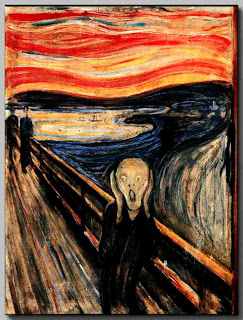
In August of 2018, the state-owned railway company of Germany, Deutsche Bahn, announced a plan to discourage homeless people and drug users from congregating in their facilities, by playing recordings of atonal music. There was an immediate, furious response from the "new music" community. They felt that using atonal music in this way tended to cast it in a negative light.
The Initiative Neue Musik, a Berlin-based organization, protested that "Art shouldn't be weaponized." They made the usual comparison to the Nazi program of banning atonal music as "Entartete Musik" (although they did not mention the CIA program of promoting it, under the aegis of the Congress for Cultural Freedom. In a Harvard Advocate article entitled "How the Avant-Garde Got Popular (or Not)", Richard Beck writes of the CCF, "In the span of a few years, the government successfully weaponized American art.")
There was enough commotion that Deutsche Bahn abandoned the program. The thing that caught our attention, however, was the term used by Deutsche Bahn to describe atonal music: "anxiety-inducing." This struck us as a rather clinically precise description of the effect of atonality.
Normally, music communicates ideas metaphorically; dissonances are understood by the mind, roughly speaking, as problems, and lawful resolutions to these dissonances are heard as solutions. An ingenious solution to a difficult problem, couched in musical language, is beautiful, a joyful experience. When music is stripped of this function, it becomes either a purely sensory experience, or an exercise in cognitive frustration: a barrage of problems without solutions. If dissonance becomes purely a sensual effect, it is robbed of its potency; it can no longer be a singularity that piques the curiosity of the listener, but rather, just another event in a series of auditory stimuli.
Imagine watching a drama in which each scene, or even each moment of each scene, is unconnected to what comes before and after it. The mind searches urgently for an ordering principle, but in vain. The absence of a progression of ideas, the complete lack of a denouement that could resolve all paradoxes and teach us something: this is indeed "anxiety-inducing."
Was it intended to be so? One of the chief ideologues of "new music" was Theodor Adorno, who in 1946 wrote a book entitled The Philosophy of Modern Music, in which he said:
What radical music perceives is the untransfigured suffering of man.... The seismographic registration of traumatic shock becomes, at the same time, the technical structural law of music. It forbids continuity and development. Musical language is polarized according to its extreme; towards gestures of shock resembling bodily convulsions on the one hand, and on the other towards a crystalline standstill of a human being whom anxiety causes to freeze in her tracks.... Modern music sees absolute oblivion as its goal. It is the surviving message of despair from the shipwrecked.
The question then becomes: who "weaponized" art? It wasn't Deutsche Bahn. What Adorno reflects in his disturbing manifesto is the influence of existentialist philosophy on the arts. Robert C. Solomon, in his book, Existentialism, describes an "the existential attitude", or a sense of disorientation, confusion, or dread in the face of an apparently meaningless or absurd world. We think that it might be fair to liken the experience of listening to atonal music to this "existential attitude." The question becomes, why would someone want to produce "art" that evokes this? Surely not just to chase away the homeless.
|